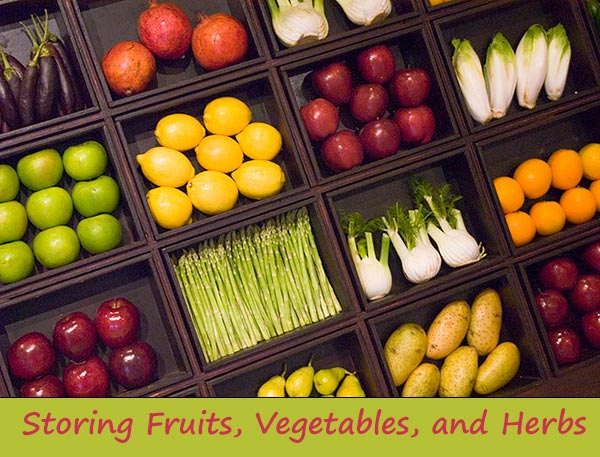Storing Fruits, Vegetables, and Herbs

It’s harvest time! For many home gardeners that means a beautiful bounty of home-grown fruits, vegetables, and herbs, while others prefer to take advantage of the work of others by finding the best bargains on fresh items at the local farmer’s market or grocery store. The only trouble about this healthy harvest comes into play if your fresh produce withers and wilts before you have a chance to eat it. That can lead to a waste of food, as well as money and hard work.
The simple solution to preventing this loss is knowing how to properly store fresh foods so they can be used at a later date. How foods are stored will have a major impact on their taste and texture when you are ready to use them. Following are some simple storage methods for your fresh produce that can have you eating healthy and delicious foods well beyond harvest time.
Short-Term Storage
To Refrigerate or Not to Refrigerate:
The short answer is, yes… nearly all fresh produce can be refrigerated to preserve its quality, with a few exceptions, like bananas, tomatoes, lemons and limes, and root vegetables like potatoes. Those items should be kept in a cool, dry area, but will experience changes and spoilage if kept too cool. Garlic and onions should also be kept at room temperature or cooler, and in a well-ventilated area. In regard to refrigerating produce, crisper drawers on most modern fridges do a great job of protecting fruits and vegetables, as many even have ways of controlling the humidity of the items you’re storing.
With any produce, it is best to eat it as quickly as possible after harvesting as flavor and nutrient values tend to degrade the moment something is picked. As that is not always an option, there are ways to preserve certain things, if you are able to give them the individual attention and consideration they need. Specific tips are as follows:
Vegetables:

Tomatoes can be tricky to keep fresh. Refrigeration of tomatoes will give them an unpleasant grainy texture and kill the natural aroma and flavors within. Tomatoes, therefore, should always be stored at room temperature and kept unwashed until just before use.
Vidalia onions have a high water content and can be stored in a refrigerator, but should be first individually wrapped in either paper towels or aluminum foil.
Eggplant tends to go bad very quickly and should be used within a couple of days of harvest or purchase, meanwhile, it should be stored in a cool and dry environment.
Asparagus is best stored in the refrigerator with either a moist paper towel wrapped around the stems or stood up in a glass of cold water with a damp paper towel wrapped around the tops to maintain crispiness. Even under refrigeration, asparagus will only be at its peak for a few days when stored.
Mushrooms can be kept under refrigeration or in a cool, dry environment, the key to keeping them is to only wash them or expose them to excessive moisture immediately before use.
For many vegetables, including root vegetables like potatoes, old-school root cellars are the perfect storage environment. Assuming you don’t have a root cellar at your disposal, the key with keeping potatoes is to keep them in a cool, dry place with adequate ventilation. If refrigerated, the starch within potatoes will convert to sugar which will make them less resistant to the cold, but negatively impact flavor, creating faux sweet potatoes. Real sweet potatoes, on the other hand, are even more delicate than other varieties, and should only be kept for about a week before use.
Carrots should be stored in the fridge inside a plastic bag to maintain moisture. Only clean and peel carrots immediately before using.
Pre-washed lettuce can be a big timesaver for you in terms of washing and storage, however some of the spoilage-retardant chemicals can negatively impact flavor. If cleaning and storing your own lettuce, the best method is to fill a large bowl with cold water, break off and dip leaves in the water repeatedly. Change water as needed until the water remains clean. Dry leaves very well with towels or a spinner, and store in a dry plastic bag atop paper towels similarly to fresh herbs.
Fruit:

Many fruits are harvested and sold slightly under ripe, and many can be ripened to ideal conditions in your kitchen at room temperature. The trick is to avoid allowing them to become overripe. One of the most temperamental examples of this is cantaloupe. These melons will go from ripe to overripe very quickly, but cannot be stored in the refrigerator as they will get rubbery and lose a great deal of their flavor.
Berries can go bad quickly for the most part, though berries with thicker skins such as blueberries and cranberries can keep much longer. Delicate berries like strawberries and raspberries do best in the refrigerator and should only be washed just before use. Monitor closely as once a few berries start to decay, they will quickly spread their condition to others… a “One bad apple spoils the bunch” scenario.
Rhubarb should be wrapped in plastic and stored in the fridge for best results, but unless planning to use if quickly, would be best served being frozen for long-term storage.
Pears, peaches, plums, and mangoes can be ripened at room temperature until they are tender to the touch, and should then be refrigerated or used as soon as possible to avoid spoilage.
Pineapple tends to concentrate its natural sugar at the base of the fruit, so you can store them upside-down for a day or two either on the counter or in the fridge to allow the flavor to even out. Still, pineapple should be used within a few days of purchase.
Lemons and limes do not do well under refrigeration. Not only does the cool, moist air lead to spoilage, they also tend to absorb odors from other items in the fridge.
Apples can be stored for up to four months in a refrigerator or under proper cool and dark conditions, but again, monitor them to make sure that one bad apple doesn’t spoil the bunch!
Bananas should never be refrigerated, as anything under 58 degrees will cause browning and damage.
Herbs:

The best way to preserve fresh herbs under refrigeration is to wash them, dry them well, snip the ends, and then stand them up in a glass of water. You can then tent the tops with a plastic bag or a damp paper towel to help preserve moisture.
With washed and dried herbs, you can also store them in a plastic bag atop a paper towel to absorb excess moisture while maintaining a humid environment.
Page 1 0f 2
 Home and Gardening Ideas At home and Gardening ideas we believe inspiring readers about homesteading, self sufficiency
Home and Gardening Ideas At home and Gardening ideas we believe inspiring readers about homesteading, self sufficiency





